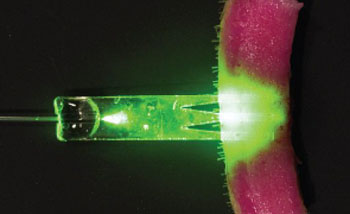Fiber-Optic Technology Helps Heal Wounds Faster
By HospiMedica International staff writers
Posted on 21 Feb 2016
A new technique helps deliver light deeper into human tissue, potentially healing wounds faster and treating tumors more efficiently.Posted on 21 Feb 2016
Developed by researchers at the University of St. Andrews (Fife, United Kingdom) and Harvard Medical School (Boston, MA, USA), Pohang University of Science and Technology (Gyeongsangbuk-do, Republic of Korea), and other institutions, the technology is based on photochemical tissue bonding (PTB) based on biocompatible, biodegradable polymers. The polymers are used to fabricate optical waveguides which can be inserted into the body to deliver light to heal internal wounds locally, for example after surgery.

Image: Cross-section of the photo-activated area of dyed porcine skin with a planar PTB waveguide (Photo courtesy of the University of St. Andrews).
The implantable light-delivery waveguides may be used for long-term light delivery, and need not be removed as they are gradually resorbed by the tissue. Using a comb-shaped planar waveguide, the researchers were able to achieve full thickness (over 10 mm) wound closure of porcine skin, which represents around a 10-fold extension of tissue depth achievable with conventional PTB. According to the researchers, the results point to potential photomedicine uses in deep tissues. The study was published on January 19, 2016, in Nature Communications.
“The potential applications of biodegradable polymer waveguides are expected to go far beyond PTB,” concluded lead author Sedat Nizamoglu, PhD, of Harvard Medical School and Koç University (Istanbul, Turkey), and colleagues. “Implantable waveguides can extend the therapeutic depths in photodynamic and photothermal therapies; enable deep tissue stimulation by low-level light or optogenetic techniques; and offer new strategies for continuous monitoring of medical conditions and sensing diagnostic information.”
“A variety of optical techniques, such as photochemical tissue bonding and photodynamic therapy, require efficient delivery of light deep into tissues, but the current limited penetration of light in tissue constitutes a serious constraint in clinical use,” added study coauthor Prof. Malte Gather, PhD, of the University of St. Andrews. “Having biocompatible and bioabsorbable optical components may transform photomedicine from a discipline where light is predominantly applied externally, to a new paradigm based on tissue-integrated and precisely controlled delivery and collection of light.”
Related Links:
University of St Andrews
Harvard Medical School
Pohang University of Science and Technology














